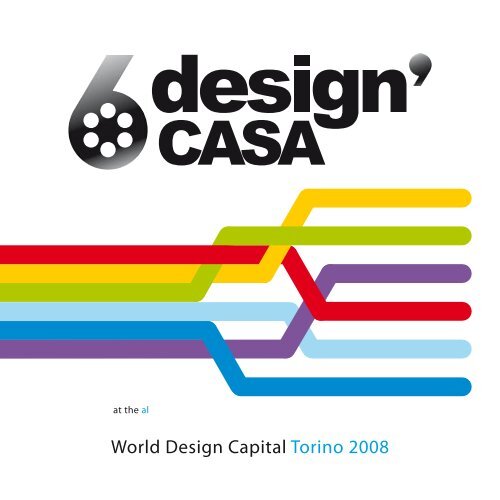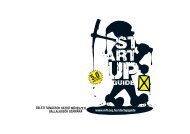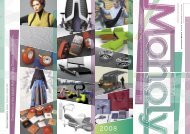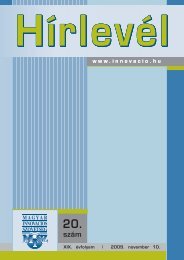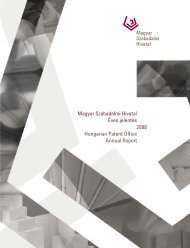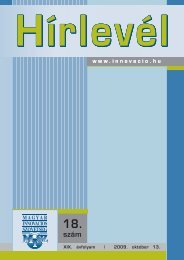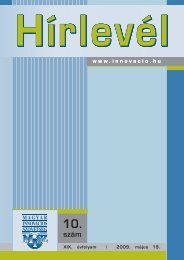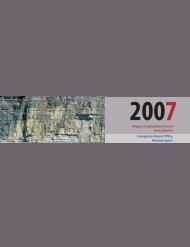You also want an ePaper? Increase the reach of your titles
YUMPU automatically turns print PDFs into web optimized ePapers that Google loves.
at the al<br />
<strong>World</strong> <strong>Design</strong> <strong>Capital</strong> <strong>Torino</strong> <strong>2008</strong>
Partners Partner<br />
Estonian Association of <strong>Design</strong>ers, Tallinn<br />
Associazione dei <strong>Design</strong>er Estoni, Tallinn<br />
www.edl.ee<br />
Hungarian <strong>Design</strong> Council, Budapest<br />
Consiglio <strong>Design</strong> d’Ungheria, Budapest<br />
www.mft.org.hu<br />
<strong>Design</strong> Information Centre, Riga<br />
Centro Informazioni del <strong>Design</strong>, Riga<br />
www.dic.lv<br />
Lithuanian <strong>Design</strong> Forum, Vilnius<br />
Forum <strong>Design</strong> Lituano, Vilnius<br />
www.dizainoforumas.lt<br />
SPFP - The Association of Industrial <strong>Design</strong>ers in Poland, Warsaw<br />
SPFP – Associazione dei <strong>Design</strong>er Industriali della Polonia, Varsavia<br />
www.spfp.diz.pl<br />
The Silesian Castle of Art and Enterprise, Cieszyn<br />
Castello d´arte e impresa Salesiano, Cieszyn<br />
www.zamekcieszyn.pl<br />
The Slovak <strong>Design</strong> Centre, Bratislava<br />
Centro Slovacco del <strong>Design</strong>, Bratislava<br />
www.sdc.sk<br />
Curator Curatore della mostra<br />
Judit Várhelyi, Director, Hungarian <strong>Design</strong> Council
Six <strong>Design</strong> Stories<br />
Sei Storie di <strong>Design</strong><br />
at the al <strong>World</strong> <strong>Design</strong> <strong>Capital</strong> <strong>Torino</strong> <strong>2008</strong><br />
Artintown Gallery, Via Berthollet 25, 10125 <strong>Torino</strong><br />
estonia<br />
ungheria<br />
lithuania<br />
estonia<br />
hungary<br />
poland<br />
slovakia<br />
latvia<br />
lettonia<br />
lituania<br />
polonia<br />
slovacchia<br />
November Novembre 06 - 13<br />
<strong>2008</strong>
INTRODUCTION<br />
INTRODUZIONE<br />
At the invitation of <strong>Torino</strong>, the <strong>World</strong> <strong>Design</strong><br />
<strong>Capital</strong> of <strong>2008</strong>, six countries have joined forces<br />
to transform the Artintown Gallery into a shared<br />
“<strong>Design</strong> Casa”, featuring a specially commissioned<br />
installation of national design icons.<br />
The installation illustrates design stories from<br />
the Baltic to the Adriatic – stories of traditions,<br />
challenges and achievements. These stories,<br />
sometimes bold, sometimes quirky, reveal<br />
an emerging, vibrant design culture,<br />
ready to reinvent itself.<br />
During the event, a selected program of short<br />
animations will be screened daily.<br />
All’invito di <strong>Torino</strong>, per <strong>World</strong> <strong>Design</strong> <strong>Capital</strong><br />
del <strong>2008</strong>, si sono unite sei nazioni per trasformare<br />
la galleria Artintown in una “<strong>Design</strong> Casa” condivisa,<br />
con la partecipazione speciale delle icone nazionali<br />
del design.<br />
L’allestimento illustra il design storico dal Baltico<br />
all’Adriatico – storie di tradizioni, sfide e successi.<br />
Queste storie qualche talvolta coraggiose e talvolta<br />
improvvisate, rivalgono una cultura emergente,<br />
vibrante già pronta a reinvetare se stessa.<br />
Durante l’evento, una selezione di brevi filmati di<br />
animazione saranno mostrate giornalmente.<br />
6 - 13 November Novembre <strong>2008</strong>
FOREWORD<br />
FOREWORD<br />
As you admire this fascinating compilation of<br />
famous design icons of the past and challenging,<br />
thought-provoking new creations of modern-day<br />
design from Central Europe, spare a moment to<br />
listen to other visitors’ comments…<br />
“I didn’t know the Minox was designed by an<br />
Estonian!” “But I just assumed Marcel Breuer<br />
was French or German, with a name like that…”<br />
“Well, yes, now I remember: the Rubik cube<br />
comes from Hungary…”<br />
Before the First <strong>World</strong> War, the countries<br />
represented here were the cutting edge of design<br />
and manufacturing in the Tsarist and Danube<br />
empires, a status they defended vigorously,<br />
amid a million economic hardships, during their<br />
period of complete independence between the two<br />
wars. Despite an inevitable postwar talent drain,<br />
they were back in a leading position in the Eastern<br />
bloc within two decades and are now demonstrating<br />
that it is indeed possible to build on a humus<br />
of local crafts and industrial traditions… and win<br />
hotly-contested international awards, competing<br />
against the best the world has to offer.<br />
Maybe you were already familiar with the celebrated<br />
icons, but if this is the first time you have<br />
encountered the fresh design wind blowing in<br />
from Central Europe, you are in for a treat!<br />
Pete Kercher EIDD Ambassador<br />
Mentre ammirate questa affascinante raccolta di<br />
famose icone del design del passato e nuove creazioni<br />
di design contemporaneo dall’Europa Centrale<br />
– che sfidano quanto fanno riflettere – fermatevi un<br />
attimo ad ascoltare i commenti di chi vi circonda…<br />
“Non sapevo che a progettare la Minox fosse un<br />
estone!” “Ma… con un nome così, Marcel Breuer<br />
non era francese, o forse tedesco?” “Ma si, certo,<br />
ora mi ricordo: il cubo di Rubik arriva dall’Ungheria…”<br />
Prima della prima guerra mondiale, i paesi rappresentati<br />
qui erano all’avanguardia per il design<br />
e la produzione negli imperi Tsarista e del Danubio,<br />
una condizione che difesero a spada tratta, tra mille<br />
avversità economiche, nel periodo di completa<br />
indipendenza tra i due grandi conflitti continentali.<br />
Nonostante un’inevitabile perdita di talento nel<br />
dopoguerra, entro due decenni già occupavano<br />
di nuovo posizioni di guida nel blocco sovietico<br />
e ora stanno qui a dimostrazione che è sì possibile<br />
costruire su un humus di tradizioni locali artigianali<br />
ed industriali… e vincere ambitissimi premi internazionali<br />
in concorrenza con il meglio che il resto del<br />
mondo può offrire.<br />
Forse conoscevate già le icone più celebri, ma se<br />
questa è la prima volta che incontrate il fresco vento<br />
progettuale che soffia dall’Europa Centrale, state per<br />
scoprire una gradevolissima sorpresa!<br />
Pete Kercher Ambasciatore EIDD
estonia estonia
Basic lamp lampada 1997<br />
<strong>Design</strong>ed by <strong>Design</strong> di Tarmo Luisk<br />
Produced by Prodotto da 4Room<br />
Photo Foto <strong>Design</strong>er’s archive Archivio del designer<br />
www.dak.ee<br />
Variable light collection<br />
of industrial romance.<br />
Collezione di lampade<br />
da tavolo in stile industrial-romantico.<br />
5
Plywood suitcase Valigia in compensato 1890<br />
Produced by Prodotto da Luther Factory<br />
Photo Foto <strong>Design</strong>er’s archive Archivio del designer<br />
Estonians are especially proud of<br />
the Luther plywood factory, which drew<br />
designers from all over the world owing<br />
to the fact that it used modern technology<br />
and was open to innovative ideas. The<br />
factory boasted novel products made of<br />
pre-formed plywood and suitcases made<br />
of waterproof cardboard and plywood.<br />
Gli estoni sono veramente molto<br />
fieri della loro industria di compensato<br />
Luther, nella quale lavorano tanti designer<br />
provenienti da tutto il mondo, anche<br />
perché usa la tecnologia più moderna<br />
e perché aperta alle idee più innovative.<br />
La fabbrica vantava nuovi prodotti costituiti<br />
da compensato pre-formato e valigie<br />
di cartone e compensato impermeabile.<br />
6
Minox camera camera 1936<br />
<strong>Design</strong>ed by Progetto di Walter Zapp<br />
Photo Foto <strong>Design</strong>er’s archive Archivio del designer<br />
(VEF) Walter Zapp invented this “spy”<br />
camera, probably better known to us<br />
through James Bond films in Tallinn.<br />
It was produced in Riga.<br />
(VEF) Walter Zapp creò questa “spy”<br />
camera a Tallinn, probabilmente, a noi<br />
meglio conosciuta attraverso i film<br />
di James Bond. È stata poi prodotta a Riga.<br />
7
Martin table tavola 1988<br />
<strong>Design</strong>ed by Progetto di Martin Pärn Produced by Prodotto da Martela<br />
Photo Foto <strong>Design</strong>er’s archive Archivio del designer<br />
The one and only Red Dot winner<br />
from Estonia: “Best of the Best” of contest<br />
Red Dot, “<strong>Design</strong> Innovation 98” for the<br />
folded table “Martin”. In 1999 the German<br />
magazine of furniture design “MD” chose<br />
the folded table Martin among 2000 best<br />
pieces of furniture of the last century.<br />
L’unico ed il solo vincitore del Red Dot<br />
dall’Estonia: “Il meglio del meglio” del Red<br />
Dot, “Progetto Innovativo 98” per la tavola<br />
piegata “Martin”. Nel 1999 la rivista tedesca<br />
di progettistica di mobili “MD” annoverò<br />
la tavola piegata di Martin tra i 2000<br />
migliori mobili dell’ultimo secolo.<br />
8
Dixi furniture mobile 2006 <strong>Design</strong>ed by Progetto di Igor Volkov, LUM<br />
Client Cliente Aarnon Puu OY Finland Produced by Prodotto da Entopt OÜ Estonia<br />
Photo Foto <strong>Design</strong>er’s archive Archivio del designer<br />
The collapsible plywood nursery<br />
furniture “Dixi” won 1st prize in the<br />
Estonian-Finnish competition 10D<br />
and the young designers´ prize “SÄSI”.<br />
Il mobile a scrocco di compensato<br />
„Dixi“ ha vinto il 1° premio alla<br />
competizione Estonea-Finnlandese 10D<br />
ed alla gara per giovani designer vinto<br />
il premio “SÄSI”.<br />
9
hungary ungheria
Wassily chair sedia 1925<br />
<strong>Design</strong>ed by Progetto di Marcel Breuer<br />
Photo Foto Vitra<br />
www.marcelbreuer.org<br />
Born in 1902 in Pécs, Hungary, Marcel<br />
Bauer was arguably the most influential<br />
furniture designer of the twentieth<br />
century. As head of the furniture workshop<br />
at the Bauhaus in Dessau, he started<br />
experimenting with bent tubular steel<br />
frames, inspired by the curved handlebar<br />
of the bicycle he rode to work. The ‘Model<br />
B3’ chair, as it was originally called, is still in<br />
production today. The chair became known<br />
as the “Wassily” after the painter Kandinsky,<br />
Breuer’s friend and fellow Bauhaus<br />
instructor, who praised the design<br />
when it was first produced.<br />
Marcel Breuer, nato a Pécs nel 1902,<br />
è forse l’artista più influente ed importante<br />
del ventesimo secolo. Come responsabile<br />
della mobilia presso il seminario la<br />
Bauhaus a Dessau, iniziò a sperimentare<br />
una struttura in acciaio tubolare curvato,<br />
ispirato al manubrio della bicicletta sulla<br />
quale si recava a lavoro. La sedia „Model<br />
B3“, come è stata chiamata originariamente,<br />
è ancora oggi in produzione. La sedia è poi<br />
diventata nota come la „Wassily“ dopo che<br />
il pittore Kandinsky, amico e collega di<br />
Breuer, istruttore a Bauhaus, elogiò il design<br />
quando fu prodotta per la prima volta.<br />
11
Rubik’s cube Cubo di Rubik 1977<br />
<strong>Design</strong>ed by Progetto di Ernő Rubik<br />
Photo Foto György Kaczúr<br />
www.rubikstudio.hu<br />
The single most famous Hungarian<br />
brand, the Rubik’s Cube has been puzzling<br />
the world since 1977. Originally designed as<br />
a teaching aid, the Cube ended up a design<br />
classic and the world’s best selling toy, with<br />
nine-digit sales. Although the height of the<br />
‘Rubiks craze’ was in the mid-1980s,<br />
the Cube still attracts devotees from<br />
all over the world, who hold regular<br />
‘speedcubing’ competitions.<br />
Il più famoso brand ungherese,<br />
il cubo di Rubik gira il mondo dal 1977.<br />
Originariamente concepito come<br />
strumento utile per l’insegnamento, il cubo<br />
con il suo design classico è finito per<br />
diventare il giocattolo più venduto<br />
al mondo, con un numero a nove cifre.<br />
Anche se il massimo della „ Cubo di Rubik<br />
follia” è stata a metà degli anni 1980, il Cubo<br />
ancora attira devoti da tutto il mondo,<br />
che si cimentano regolarmente in<br />
competizioni di “speedcubing”.<br />
12
Egg cup Coppa porta uovo 2002<br />
<strong>Design</strong>ed by Progettato da Geppetto <strong>Design</strong> Studio<br />
Photo Foto Dániel Horváth<br />
www.geppetto.hu<br />
Witty and provoking, the Egg Cup,<br />
like the spoons that it is made of, is<br />
a simple, highly functional object.<br />
Made of three coffee-spoons, the object<br />
evokes the scene it has been made for – the<br />
ritual of a leisurely Sunday brunch. As the<br />
designers say, the idea was lying on the<br />
table...<br />
Spiritosa e provocatoria la tazza per<br />
l’uovo, composta di cucchiai, è un oggetto<br />
semplice e altamente funzionale. Creato<br />
con tre cucchiaini da caffé, l’oggetto evoca<br />
la scena per il quale è stato creato – ovvero<br />
un piacevole brunch domenicale. Come<br />
dicono i designer, l’idea era distesa già sul<br />
tavolo…<br />
13
Etalon Essence loudspeaker cassa altoparlante 2006<br />
<strong>Design</strong>ed by Progetto di Pál Koós Produced by Prodotto da Etalon Acoustics Ltd.<br />
Photo Foto Manders Foto<br />
www.etalonacoustics.com<br />
A love of music and legends of high<br />
achievements run through the Hungarian<br />
history. The Etalon Essence loudspeakers<br />
were conceived in this tradition and aim to<br />
achieve a life-like reproduction of sound.<br />
The design matches the high-quality<br />
performance with a graceful shape.<br />
Each loudspeaker is hand-made, using<br />
choice components and materials.<br />
La storia ungherese è piena di atti<br />
d’amore per la musica, il leggendario<br />
musicismo ungherese. L’altoparlante<br />
Etalon Essence è stato concepito in questa<br />
tradizione con l’obiettivo di raggiungere<br />
una qualità di riproduzione dei suoni<br />
simili a quelli reali. Il designer combina<br />
una qualità eccezionale della riproduzione<br />
acustica ad una forma gradevole.<br />
Ogni cassa è fatta a mano con materiali<br />
e componenti di primissima scelta.<br />
14
Corvus Phantom aircraft aeroplani <strong>2008</strong><br />
By Di Corvus Aircraft Ltd.<br />
Photo Foto Corvus Aircraft Ltd.<br />
www.corvus-aircraft.hu<br />
Hungarian aircraft design has an<br />
illustrious history. This ultra light craft uses<br />
state-of-the-art technology and materials<br />
to achieve speed, lightness and stability.<br />
The interior, with side-by-side seats and<br />
high quality finishes, offers the comfort<br />
of automobiles. Due to short take off and<br />
landing distances, the aircraft can also<br />
be efficiently used at small, grass covered<br />
landing sites.<br />
Gli aeroplani ungheresi hanno una<br />
storia illustre. In questo ultraleggero<br />
ritroviamo lo stato dell’arte della tecnologia<br />
e dei materiali, per ottenere velocità,<br />
leggerezza e stabilità. L’interno, con i sedili<br />
da parte a parte e le rifiniture di alto pregio,<br />
offre un comfort paragonabile<br />
ad un automobile. Capace di decollare ed<br />
atterrare in poco spazio, l’aereo può anche<br />
essere utilizzato in modo efficiente anche<br />
su piste in erba molto piccole.<br />
15
latvia lettonia
VEF-SPĪDOLA radio receiver ricevitore radio 1962<br />
<strong>Design</strong>ed by Progetto da Ādolfs Irbīte Produced by Prodotto da VEF<br />
Photo Foto Publicity Photo<br />
“An artist-designer must not pander<br />
to a customer’s wishes. The customer must<br />
be educated by means of good examples<br />
– this is the main task of an artist-designer.<br />
A new era sets new tasks for a designer,<br />
and these tasks change the character<br />
of a designer’s work. He is no more an<br />
artist who works alone but a coordinator,<br />
an organizer and a member of a creative<br />
collective.” (Ādolfs Irbīte, 1981)<br />
“Un artista-designer non deve<br />
dipendere dalle esigenze dei clienti.<br />
Il cliente deve essere educato sul senso,<br />
con buoni esempi - questo è il motto<br />
principale di un artista-designer.<br />
Una nuova era significa nuove emozioni<br />
per un designer e questi stimoli possono<br />
cambiare il carattere del lavoro di un<br />
designer. Lui non è soltanto un’artista<br />
che lavora solo, ma coordina ed organizza<br />
un collettivo creativo.” (Ādolfs Irbīte, 1981)<br />
17
Stella mini mokick 1986<br />
<strong>Design</strong>ed by Progetto di Gunārs Glūdiņš<br />
Photo Foto <strong>Design</strong>er’s archive Archivio del designer<br />
Produced by Prodotto da Sarkanā Zvaigzne<br />
Mokicks and micro rollers - the<br />
household motor vehicles created by<br />
Gunārs Glūdiņš and a team of constructors<br />
of the plant Sarkanā Zvaigzne mark<br />
a period in the history of Latvian design.<br />
The first models were developed at the<br />
beginning of the 1970s as a novelty in<br />
Eastern bloc countries and represented the<br />
achievements of the USSR design<br />
at international exhibitions. In the 1980s<br />
the next generation of mokicks, the “mini”<br />
series and foldable versions were created.<br />
According to specialists the model Stella<br />
was one of the most successful ones,<br />
and it was very popular among the general<br />
public. The mokick was designed in<br />
cooperation with the plant ZVL in Kolárovo,<br />
former Czechoslovakia, where engines<br />
for this model were made.<br />
Mokicks e il micro monopattino<br />
– veicoli motorizzati per uso casalingo<br />
creati da Gunārs Glūdiņš e dal team<br />
dell‘esecutore del progetto Sarkanā<br />
Zvaigzne caratterizzano il design lettone<br />
di questo periodo storico. I primi modelli<br />
sviluppati all’inizio degli anni 1970 come<br />
una novità assoluta nei paesi comunisti,<br />
rappresentavano il design dell’Unione<br />
Sovietica alle mostre internazionali. Negli<br />
anni 1980 nasceva la seconda generazione<br />
di mokick con nuovi modelli di “mini” che<br />
potevano anche essere piegati. In accordo<br />
con gli specialisti di settore, il modello<br />
Stella è stato uno dei più famosi e noti<br />
articoli conosciuti dal grande pubblico<br />
ed hanno avuto veramente molto di<br />
successo. Il mokick è stato progettato in<br />
cooperazione con lo stabilimento ZVL di<br />
Kolárovo in Cecoslovacchia, ove era stato<br />
creato anche il motore per questo modello.<br />
18
Next seat sedia 2005 <strong>Design</strong>ed by Progetto di Anastasija Mass<br />
Produced by Prodotto da Saga Group limited edition edizione limitata<br />
Photo Foto Anastasija Mass<br />
A seat with several elements.<br />
For each person a next element must be<br />
added to the existing one already placed.<br />
Created during Nordic design workshops<br />
in Riga, under supervision of Boris Berlin.<br />
Anastasija Mass believes that aesthetics<br />
and proportions play a key role<br />
in this design. Together with Elīna<br />
Bušmane, Kaspars Jursons and Jānis<br />
Valdmanis she represents a designers’ team<br />
directdesign.lv whose objective is to create<br />
practical and contemporary design.<br />
Per ogni persona si deve aggiungere<br />
un elemento seguente agli esistenti.<br />
Creato durante un Nordic workshop<br />
a Riga, sotto la supervisione di Boris Berlin.<br />
Anastasija Mass crede fermamente,<br />
che l’estetica e la proporzione giochi<br />
un ruolo fondamentale nel design.<br />
Insieme ad Elīna Bušmane, Kaspars<br />
Jursons e Jānis Valdmanis, rappresenta<br />
l’associazione, derictdesign.lv che ha<br />
come obiettivo la creazione di un design<br />
particolare e contemporaneo.<br />
19
Across coffee table tavola da caffé <strong>2008</strong><br />
<strong>Design</strong>ed by Progetto di Kaspars Jursons<br />
Photo Foto Reinis Hofmanis<br />
www<br />
Exhibited in Salone Internazionale<br />
Del Mobile Salone Satellite <strong>2008</strong><br />
Acros is a space-saving and easy-to-fold<br />
coffee table. Created as a study work at<br />
the <strong>Design</strong> Department of the Academy<br />
of Arts of Latvia. Kaspars Jursons also<br />
represents the flourishing designers’ team<br />
directdesign.lv. The team generates a belief<br />
in stable, contemporary and competitive<br />
development of design in Latvia. Kaspars<br />
Jursons has a rational approach to design.<br />
Logic is the most important quality for<br />
him even when looking for untraditional<br />
solutions.<br />
Esposto al Salone Internazionale<br />
Del Mobile Salone Satellite <strong>2008</strong><br />
Una tavola da caffé salvaspazio<br />
facilmente chiudibile. Creato come un<br />
lavoro di studio per il Dipartimento di<br />
<strong>Design</strong> dell’Accademia delle Arti di Lettonia<br />
(con la supervisione di Barbara Ābele e Juris<br />
Krūmiņš). Anche Kaspars Jursons fa parte<br />
della fiorente associazione di designer<br />
directdesign.lv. L’associazione crea uno<br />
sviluppo competitivo e contemporaneo<br />
del design in Lettonia. Kaspars Jursons<br />
ha un’approccio razionale del design.<br />
La logica per lui è la qualità più importante,<br />
anche quando cerca una soluzione non<br />
tradizionale.<br />
20
Staklis 2004<br />
<strong>Design</strong>ed by Progetto di Elīna Bušmane<br />
Photo Foto Elīna Bušmane<br />
First prize in SaloneSatellite <strong>World</strong>wide,<br />
Moscow, 2005. Exhibited in Salone<br />
Internazionale del Mobile<br />
SaloneSatellite 2006<br />
An ethnographic milking stool influenced<br />
the creation of staklis. It contains the<br />
ancient Latvian wisdom regarding the<br />
efficient usage of material. It represents the<br />
bare minimum people need to sit down.<br />
The stool consists of easily mountable and<br />
similar parts. It is easy to set up and to take<br />
apart. It takes up a very small amount of<br />
space when assembled. Created as a study<br />
work at the <strong>Design</strong> Department of the<br />
Academy of Arts of Latvia (supervisors<br />
Barbara Ābele and Juris Krūmiņš).<br />
Elīna Bušmane is a forceful young Latvian<br />
designer and a driving force of the team<br />
directdesign.lv. The relationship between<br />
design and human beings are vital for her<br />
in design.<br />
Primo premio al SaloneSatellite<br />
Mondiale a Mosca nel 2005. Esposto<br />
nel Salone Internazionale del Mobile<br />
SaloneSatellite 2006<br />
Una tavola per la mungitura etnografica<br />
ha influenzato la creazione di staklis.<br />
Contiene l’antica saggezza della<br />
Lettonia nell’uso efficiente dei materiali.<br />
Rappresenta che qualunque uomo ha<br />
bisogno di sedersi. Lo sgabello consiste in<br />
parti simili e facilmente montabili.<br />
La creazione è facile da montare<br />
e smontare. Quando è assemblato, occupa<br />
pochissimo spazio. Creato come un<br />
prototipo di studio per il Dipartimento<br />
di <strong>Design</strong> dell’Accademia degli Arti di<br />
Lettonia (con la supervisione di Barbara<br />
Ābele e Juris Krūmiņš) Elīna Bušmane è una<br />
fortissima e giovane designer Lettone,<br />
e punto di riferimento nell’associazione<br />
del directdesign.lv. Per lei la relazione tra<br />
design e l’essere umano è vitale.<br />
21
lithuania lituania
Kudirka chair sedia 2007<br />
<strong>Design</strong>ed by Progetto di Paulius Vitkauskas<br />
Produced by Prodotto da Contraforma<br />
Photo Foto <strong>Design</strong>er’s archive Archivio del designer<br />
www.contraforma.lt<br />
Only two years old and already<br />
a national classic. Finally it is appropriate<br />
and even desired to move about in<br />
a formal dining chair – safely. Kudirka<br />
is not a rocking chair by it‘s nature,<br />
but corresponds perfectly to the three<br />
imaginary phases of dining – straight and<br />
steady during the speeches, leant forward<br />
a bit when wrestling with that mighty<br />
lobster, and allowing to sit back after<br />
a dessert. Or why don‘t we used it<br />
for schools? With an embedded<br />
movement counter.<br />
Ha soltanto due anni, ma è già un<br />
pezzo classico nazionale. Finalmente<br />
è appropriato ed anche desiderabile<br />
di muoversi in una sedia da pranzo<br />
formale - con sicurezza. Kudrika di<br />
natura non è una sedia a dondolo, ma<br />
corrisponde perfettamente alle tre fasi<br />
immaginari del pranzo - diritto e costante<br />
durante i discorsi, appogiata in avanti<br />
durante il combattimento con l’aragosta,<br />
e comodamente accogliente all’indietro<br />
dopo il dolce. Oppure, perché non la<br />
usiamo per le scuole? Con un contatore<br />
di movimenti incorporato.<br />
23
Logo sofa divano 2005<br />
<strong>Design</strong>ed by Progetto di Nauris Kalinauskas<br />
Produced by Prodotto da Softimus<br />
Photo Foto <strong>Design</strong>er’s archive Archivio del designer<br />
www.softimus.lt<br />
Red Dot Award winner 2007<br />
A characteristic feature of the Logo<br />
seating is its light construction and fresh<br />
appearance. The frame is made of flexible<br />
plywood and the padding is of latex<br />
foam. Sitting down on the sofa is thus<br />
a particularly comfortable and relaxing<br />
experience. The sofa’s low weight allows<br />
it to be moved easily around the room<br />
without major effort. The integrated<br />
armrests can be freely arranged and<br />
adjusted to different sitting positions.<br />
The cover is made of natural wool fabric.<br />
Vincitore del Red Dot Award 2007<br />
Una caratteristica particolare della sedia<br />
Logo è la sua costruzione leggera e la sua<br />
apparenza fresca. La cornice è fatta di<br />
compensato flessibile e l’imbottitura è di<br />
schiuma di lattice. Per questo sedersi sul<br />
divano sarà un’esperienza particolarmente<br />
comfortevole e rilassante. Il peso leggero<br />
del divano permette di muoverlo<br />
facilmente senza fatica in qualunque parte<br />
della stanza. I braccioli integrati possono<br />
essere liberamente disposti e sistemati in<br />
diverse posizioni. Il tessuto di rivestimento<br />
è in lana naturale.<br />
24
Mama chair sedia 2007<br />
<strong>Design</strong>ed by Progetto di Rasa Baradinskienė<br />
Photo Foto <strong>Design</strong>er’s archive Archivio del designer<br />
www.rasadesign.lt<br />
Is there a warmer and gentler embrace<br />
for a hard classic? The designer dug deeply<br />
not only into Lithuanian tradition, but<br />
also in her own childhood memories to<br />
re-interpret Arne Jacobsen‘s timeless<br />
masterpiece. Created for a competition<br />
aimed at revealing the national character,<br />
this woollen ‘mom‘ makes everyone feel<br />
safe again. Hand-knitted by the designer<br />
herself, using an especially developed<br />
pattern.<br />
Esiste un’abbraccio più caldo e gentile<br />
per un pezzo classico? Il progettista ha<br />
scavato profondamente non solo nella<br />
tradizione Lituana, ma anche tra i ricordi<br />
dell’infanzia per poter reinterpretare<br />
il pezzo senza tempo di Arne Jacobsen.<br />
Creato per un concorso volto a rivelare<br />
il carattere nazionale, questa “mamma”<br />
di lana farà sentirsi tutti di nuovo al sicuro.<br />
Elaborata e prodotta dalla stessa designer,<br />
usando una schema speciale sviluppato<br />
di proposito.<br />
25
Soss chaise longue chaise longue <strong>2008</strong><br />
<strong>Design</strong>ed by Progetto di Mindaugas Žilionis<br />
Photo Foto <strong>Design</strong>er’s archive Archivio del designer<br />
www.bevargo.lt<br />
The ‘Holy Grail‘ for every designer,<br />
a fully transformable furniture, has been<br />
pursued for a long time. This is another, and<br />
very interesting take on the problem, which<br />
ease and simplicity doesn’t leave it without<br />
charm. Identical elements of a characteristic<br />
section can be put together in two ways<br />
– constructing virtually every shape<br />
needed. Originally designed to be made of<br />
extruded aluminium, the prototype so far<br />
remains in it’s glued plywood form awaiting<br />
the brave producer.<br />
Il “Santo Graal” dei designer, ovvero<br />
un mobile completamente trasformabile,<br />
è stato inseguito per tanto tempo. Questo<br />
progetto è un altro interessante modo di<br />
prendere sul serio il problema, con facilità<br />
e semplicità senza far perdere fascino<br />
alla creazione. Elementi identici di una<br />
caratteristica sezione possono essere<br />
messi insieme in due modi – in modo<br />
da comporre praticamente ogni forma<br />
possibile. Nel progetto originale<br />
la creazione dovrebbe essere di alluminio<br />
estruso, il prototipo per adesso rimane<br />
in compensato con la colla, in attesa di<br />
un produttore coraggioso.<br />
26
Romance table tavola 2004<br />
<strong>Design</strong>ed by Progetto di Neringa Dervinytė<br />
Produced by Prodotto da Contraforma<br />
Photo Foto <strong>Design</strong>er’s archive Archivio del designer<br />
www.contraforma.lt<br />
Grand prix at Baldai furniture fair,<br />
Vilnius<br />
Presented at the furniture fair, this item<br />
created quite a stir in Lithuania where<br />
for furniture production wood is almost<br />
exclusively used, touching the nerve<br />
of international ‘romantic’ trend. The tables<br />
are made in powder-coated cold-rolled<br />
metal sheet or stainless steel, perforated<br />
using laser-cut. They come in different sizes<br />
and proportions, and can be used both<br />
in- and outdoors. Double colour<br />
combination (inside and out) is particularly<br />
attractive and innovative.<br />
Grand prix alla fiera di Baldai mobili,<br />
Vilnius<br />
Presentato alla fiera del mobile, questa<br />
creazione ha quasi causato agitazione<br />
in Lituania, ove per la produzione dei<br />
mobili si usa quasi esclusivamente il legno,<br />
toccando il nervo internazionale del trend<br />
“romantico”. Le tavole sono ricoperte di<br />
polvere, fredda, lastre di metallo arrotolate<br />
oppure acciaio inossidabile perforata<br />
col laser. Prodotte in diverse misure<br />
e proporzioni, possono essere utilizzate<br />
all’interno oppure all´esterno.<br />
La combinazione doppia della colorazione<br />
(dentro e fuori) è particolarmente attraente<br />
ed innovativa.<br />
27
poland polonia
Sugar bowl Zucheriera 1937<br />
<strong>Design</strong>ed by Progettato da Julia Keilowa Produced by Prodotto da Fraget Factory<br />
Photo Foto Piotr Kochański & Michał Sielewicz<br />
This sugar bowl was most likely created<br />
for the occasion of the 1937 Exposition<br />
Internationale des Arts et Techniques dans<br />
la Vie Moderne in Paris, in which Poland<br />
took part. Julia Keilowa was known as an<br />
author of many items made of forged silver<br />
with a distinctive hammered finish, which<br />
later used to become models for mass<br />
production. The sugar bowl has the shape<br />
of a sphere and is attached to the arms,<br />
which look like a Greek cross from the top.<br />
La zuccheriera è stata creata<br />
prevalentemente per l’Esposizione<br />
Internazionale des Arts et Techniques<br />
dans la Vie Moderne a Parigi nel 1937, ove<br />
ha partecipato tra l’altro anche la Polonia.<br />
Julia Keilowa era conosciuta come l’autrice<br />
di tanti oggetti fatti di argento forgiato con<br />
rifinitura in martello, che in seguito sarebbe<br />
diventato un modello da seguire nella<br />
produzione di massa. La zuccheriera ha<br />
una forma sferica che con i bracci attaccati,<br />
sembrano formare una croce greca vista<br />
dall’alto sopra.<br />
29
Puff lamp lampada 2004<br />
<strong>Design</strong>ed by Progetto di Anna Siedlecka, Radosław Achramowicz<br />
Produced by Prodotto da Puff Buff <strong>Design</strong> Photo Foto <strong>Design</strong>er’s archive Archivio del designer www.puff-buff.com<br />
The designers used an unconventional<br />
material to build this family of lamps:<br />
PCV film. The inflated, translucent body<br />
creates a stiff and light lampshade<br />
construction. The delicate light outlines<br />
the “inflated” shape of the object.<br />
The collection includes standing and<br />
hanging lamps. This product, though<br />
it might evoke associations with the world<br />
of toys, perfectly fulfils its function, giving<br />
off a high quality volume of light.<br />
I designer hanno utilizzato dei<br />
materiali insoliti per realizzare questa linea<br />
di lampade: PCV film. Il corpo gonfiato,<br />
traslucente, crea una costruzione rigida<br />
ma nello stesso tempo leggera. La luce<br />
delicata sottolinea la forma “gonfiata”<br />
dell’oggetto. La collezione include anche<br />
lampade da terra e lampade da muro.<br />
Questo prodotto, anche se potrebbe<br />
evocare associazioni con il mondo dei<br />
giocattoli, soddisfa perfettamente la sua<br />
funzione, che sprigionano un elevato<br />
volume di qualità della luce.<br />
30
Mohohej! DIA carpet tappeto 2004<br />
<strong>Design</strong>ed by Progettato da Magdalena Lubińska, Michał Kopaniszyn<br />
Produced by Prodotto da Moho <strong>Design</strong> Photo Foto <strong>Design</strong>er’s archive Archivio del designer www.mohodesign.com<br />
Awarded Red Dot and DME Award,<br />
Silesian Icon<br />
It stands out with its originality of design<br />
and high quality of execution. The product<br />
uses traditional materials - high quality<br />
wool. Furthermore it uses the traditional<br />
method of creating highlander cloth<br />
combined with modern laser cutting<br />
technology. This carpet is a contemporary<br />
interpretation of folk art patterns and<br />
a fine example of using regional attributes<br />
to gain profits on the global market.<br />
Premiato Red Dot e DME, Silesian Icon<br />
Spicca con la sua originalità del design<br />
e alta qualità di esecuzione. Nella<br />
produzione della creazione sono stati usati<br />
materiali tradizionali – lana di prima qualità.<br />
Inoltre utilizza il tradizionale metodo<br />
di creazione di Highlander panno<br />
combinata con taglio laser moderna<br />
tecnologia. Questo tappeto è una<br />
interpretazione contemporanea<br />
di arte popolare ed un buon esempio<br />
d´applicazione di simboli regionali<br />
esempio, di denominazioni regionali per<br />
ottenere profitti sul mercato globale.<br />
31
Proton speaker set set di casse 2001<br />
<strong>Design</strong>ed by Progettato da Robert Majkut<br />
Produced by Prodotto da Tonsil<br />
Photo Foto <strong>Design</strong>er’s archive Archivio del designer<br />
www.design.pl<br />
This product diverges from the industry<br />
standards. The producer took care of the<br />
dynamic sound of the speakers, while the<br />
designer gave them a shape reminiscent<br />
of the glistening black or silver headlights<br />
of old-time cult motorbikes. The oval casing<br />
with a dome attached to the top houses<br />
a dynamic mid-range/bass speaker and<br />
a treble speaker. The column has a metal<br />
stand which allows the user to adjust<br />
its angle.<br />
Questo progetto diverge dagli<br />
standard industriali. Il produttore ha curato<br />
la dinamica del suono degli oratori, mentre<br />
il progettista ha dato loro una forma<br />
che ricorda la scintillante nero o argento<br />
fari del vecchio tempo culto moto. L’ovale<br />
telaio con una cupola allegato alla parte<br />
superiore ospita una dinamica distesa di<br />
media/basso altoparlanti e un altoparlante<br />
acuti. La colonna è stata fatta di metallo,<br />
che permette all’utilizzatore di aggiustare<br />
il suo angolo.<br />
32
Mono couch divano 2003<br />
<strong>Design</strong>ed by Progetto di Tomasz Augustyniak Produced by Prodotto da Com 40<br />
Photo Foto <strong>Design</strong>er’s archive Archivio del designer<br />
www.com40.pl<br />
This work was done by Tomasz<br />
Augustyniak, one of the most popular<br />
Polish contemporary furniture designers.<br />
He is the author of over 170 designs<br />
of home and office furniture implemented<br />
into production. His most important<br />
projects were done for Com40, Mikomax,<br />
Balma, Noti and many others. The Mono<br />
couch functions as the traditional “chaise<br />
long” with a modern form, based on simple,<br />
basic elements. Though very simple,<br />
it looks unique and remarkable.<br />
La presente creazione è stata<br />
progettata da Tomasz Augustyniak, il più<br />
famoso designer di mobili contemporaneo.<br />
Lui è l’autore di oltre 170 progetti per<br />
mobilia di casa e per ufficio che sono<br />
sempre in produzione. I suoi più importanti<br />
progetti sono stati realizzati da Com40,<br />
Mikomax, Balma, Noti e tanti altri.<br />
La funzione del divano Mono couch è simile<br />
a quella del tradizionale “chaise longue”<br />
con una forma moderna, basato su<br />
elementi semplici e basali. Sebbene<br />
molto semplice, allo stesso tempo è unico<br />
e caratteristico.<br />
33
slovakia slovacchia
Stoneguitar electric guitar chitarra elettrica 2007<br />
<strong>Design</strong>ed by Progetto di Tomáš Brichta<br />
Photo Foto Soňa Sadloňová<br />
www.slovanet.sk/brichta<br />
The experimental guitar has unlike<br />
the classical version, also 12 resonant<br />
strings. Each tone chosen on the<br />
fingerboard can resonate and also<br />
a resonant string which creates the sound<br />
similar to an echo effect. It is not a digital<br />
but acoustic effect which is recorded<br />
digitally. The guitar’s body is made from<br />
a solid and easy to form synthetic stone<br />
hi-macs. The designer is a musician as well,<br />
specialized at electric musical instruments.<br />
La chitarra sperimentale Stoneguitar<br />
non assomigliava affatto alla versione<br />
classica, aveva anche 12 stringhe resonanti.<br />
Ogni tono scelto sulla tastiera può<br />
risuonare e creare un effetto simile ad<br />
un eco. Questo non è un effetto digitale,<br />
ma acustico, il quale viene registrato<br />
digitalmente. Il corpo della chitarra<br />
è costituito da un mattone sintetico<br />
hi-macs rigido e leggero. Il progettista<br />
è anche un musicista specializzato in<br />
strumenti musicali elettrici.<br />
35
Tatrapoint Adaptive mechanical typewriter for Braille writing macchina da scrivere meccanica per la scivere in Braille 1997/98<br />
<strong>Design</strong>ed by Progetto di Rastislav Čerešňa Slovak Technical University Bratislava Università Tecnica Slovacca di Bratislava<br />
Produced by Prodotta da Švec a spol. s. r. o., Vráble Photo Foto Jana Hojstričová www.svecaspol.sk<br />
An ergonomically constructed and<br />
user-friendly tool for children and young<br />
people with eye problems. The keys are<br />
adjustable according to the size<br />
of the user’s hands, colours help children<br />
through orientation and quality materials<br />
increase durability. The design was created<br />
by a student at school studio, the product<br />
went on to production and now<br />
successfully competes on the market.<br />
La creazione è stata costruita<br />
ergonomicamente, in modo da essere<br />
utile all’utilizzatore bambino o giovane<br />
con problemi di vista. Le chiavi sono<br />
regolabili in base alle dimensioni delle mani<br />
degli utenti, i colori ad aiutare i bambini<br />
attraverso l’orientamento e la qualità<br />
dei materiali per aumentare la durata.<br />
Il disegno è stato creato da uno studente<br />
a scuola, il prodotto è poi passato alla<br />
produzione e ora si confronta con successo<br />
sul mercato.<br />
36
FRU.HAUS lamp lampada 2007<br />
<strong>Design</strong>ed by Progetto di Silvia Jokelová<br />
Photo Foto Jana Hojstričová<br />
Silvia Jokelová is a young designer<br />
who has already been a dedicated<br />
researcher of the gender stereotypes<br />
in design for some years. She offers the<br />
plastic lamp with embroidery as a semi<br />
finished product suitable for DIY.<br />
The mixture of design and folk crafts<br />
ironically reflects the conventions in the<br />
act of considering the value of human skills<br />
and the position of the designer<br />
as an unquestionable bearer of “good taste”.<br />
Silvia Jokelová è un designer giovane<br />
che si era già dedicata qualche anno fa<br />
come ricercatrice alle forme stereotipate<br />
nel design. Offre la Lamp (plastica ricamata)<br />
come prodotto semi finito per DIY.<br />
La miscela di design e arte popolare riflette<br />
ironicamente le convenzioni in atto che<br />
considerano il valore delle capacità umane<br />
e la posizione del progettista come un<br />
indiscutibile portatore di “buon gusto”.<br />
37
Vinosaurus carafes and glasses caraffe e bicchieri 2006<br />
<strong>Design</strong>ed by Progettato da Patrik Illo Produced by Prodotto da Rona, a. s., Lednické Rovne<br />
Photo Foto Ingrid Patočková<br />
www.rona.sk<br />
Glass designer Patrik Illo is known for<br />
the wide range of his work from domestic<br />
glass to free art He has worked for Slovak<br />
and Polish glass factories. He uses humour<br />
even when dealing with the classical topic<br />
of drinking glasses, e.g. in the collection<br />
of carafes. The designs were created for<br />
the Slovak glassworks factory with over<br />
hundred year tradition which is known for<br />
traditional top technology of the blown<br />
glass as well as quality machine production.<br />
Il designer del vetro Patrik Illo<br />
è conosciuto per il suo vasto lavoro che<br />
spazia dal vetro per uso domestico alla arte<br />
libera. Ha lavorato per fabbriche di vetro<br />
slovacche e polacche. Egli usa l’umorismo<br />
anche quando si tratta di un classico<br />
argomento come bicchieri, ad esempio,<br />
nella collezione delle sue caraffe. I progetti<br />
sono stati creati per la vetreria slovacca,<br />
con oltre cento anni di tradizione rinomata<br />
per la tradizionale tecnologia superiore del<br />
vetro soffiato così come l’uso di macchine<br />
di produzione di grande qualità.<br />
38
Molecul three-wheeler tre-wheeler 2007<br />
<strong>Design</strong>ed by Progetto di Štefan Klein Produced by Prodotto da Menzi Muck, Switzerland<br />
Photo Foto <strong>Design</strong>er’s archive Archivio del designer<br />
The alternative individual<br />
transportation vehicle enriches<br />
the infrastructure of bicycle transportation<br />
and is suitable for use in various seasons.<br />
The Propulsion is asynchronous engine<br />
with high efficiency supra magnets.<br />
It enables the Molecul to be small in<br />
dimension (150 x 90 x 140 cm) and feature<br />
a low weight and variability. The project is<br />
built on the grounds of the real legislative<br />
bases. The designer is an expert in the field<br />
of transportation design.<br />
Molecul è un’alternativo mezzo di<br />
trasporto individuale che arricchisce<br />
il concetto di trasporto in bicicletta<br />
e può essere utilizzato in varie stagioni.<br />
La propulsione è a motore asincrono<br />
elettrico ad alta efficienza. Questo<br />
consente al Molecul di essere di piccole<br />
dimensione (150 x 90 x 140 cm), leggero<br />
e maneggevole. Il progetto è costruito sulla<br />
base di reali basi legislative. Il progettista<br />
è un esperto in materia di trasporto<br />
e progettazione.<br />
39
The exhibition was prepared by<br />
L´esposizione e´ stata preparata da<br />
Colophon<br />
Colophon<br />
Estonia Estonia<br />
Ilona Gurjanova, Estonian Association of <strong>Design</strong>ers<br />
Hungary Ungheria<br />
Judit Várhelyi, Director, Hungarian <strong>Design</strong> Council<br />
Curator of exhibition Curatore della mostra<br />
Published by Pubblicato dal<br />
the Slovak <strong>Design</strong> Centre Bratislava Centro Slovacco del <strong>Design</strong><br />
a Bratislava<br />
Editor Editori<br />
Adriena Pekárová<br />
Lithuania Lituania<br />
Marius Dirgėla, Lithuanian <strong>Design</strong> Forum<br />
Translation Traduzione<br />
Ivana Várošová (SK-A), Agnes Kenez (IT), Raita Jurkāne (LV)<br />
Latvia Lettonia<br />
Inese Pētersone, Daina Vītoliņa, <strong>Design</strong> Information Center<br />
Graphic design of the brochure <strong>Design</strong> grafico per l’opuscolo<br />
Robert Paršo, STUPI<strong>Design</strong><br />
Poland Polonia<br />
Michał Stefanowski, Ewa Gołębiowska<br />
Print Stampa<br />
Dolis Bratislava<br />
Slovakia Slovacchia<br />
Katarína Hubová, Adriena Pekárová, Slovak <strong>Design</strong> Centre<br />
Graphic design of the installation <strong>Design</strong> grafico<br />
per l’istallazione<br />
Levente Szabó<br />
ISBN 978-80-968658-8-8
Supporters<br />
Sponsor<br />
Hungary Ungheria<br />
Lithuania Lituania<br />
Latvia Lettonia<br />
Slovakia Slovacchia<br />
Hungarian Patent Office<br />
Moholy-Nagy University of Art and <strong>Design</strong> Budapest<br />
Lithuanian Institute<br />
State Culture <strong>Capital</strong> Foundation<br />
Dizains.Nakotne <strong>2008</strong><br />
National Film Centre of Latvia<br />
Chair Baltic<br />
Ministry of Culture of SR<br />
A comprehensive database of design-related organisations (schools, associations and promotional bodies) in the Central and Eastern<br />
European region is freely available online at www.mft.org.hu/database.<br />
Un completo database legato alla progettazione ed all’organizzazione (scuole, associazioni e enti di promozione) per l’Europa centrale<br />
e orientale è liberamente disponibile on-line all’indirizzo www.mft.org.hu/database.


